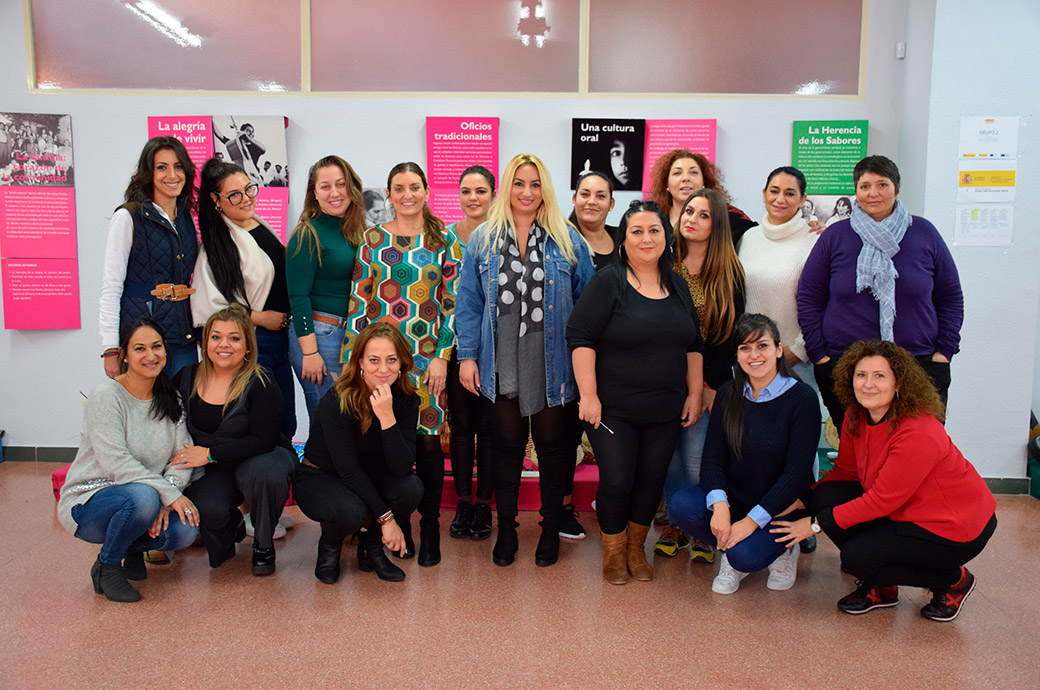Progresos y retos [editar]
Gitanos y gitanas hoy.
El Estado de Bienestar ha contribuido al progreso de las personas gitanas, cada vez con mayor presencia en el empleo por cuenta ajena, la educación, el activismo o la participación en la vida social.
España se ha transformado en las cuatro últimas décadas: nuevos modelos de familia, más tolerancia, cambios de conducta, otros roles; y las gitanas y gitanos españoles, también.
La población gitana es más joven que la media, urbana, heterogénea y en su día a día contradice los clichés que se han trasladado al imaginario social.
las familias son heterogéneas. Los matrimonios, aunque jóvenes, ya no lo son tanto y el número de hijos ha descendido.
De la chabola a una vivienda digna
Con el acceso a una vivienda digna ha mejorado también el acceso a muchos derechos. El chabolismo se ha reducido en un 87% en las últimas cuatro décadas. Esta tendencia es imparable. No obstante, todavía en 2015 quedaban 9.000 familias sin las condiciones mínimas de habitabilidad y 2.000 habitaban en chabolas.
Estudiar para tener un futuro mejor.
El sistema educativo ha incorporado tarde a niñas y niños gitanos. No ha sido hasta la década de los noventa cuando el alumnado gitano ha entrado en las aulas masivamente. Hoy prácticamente la totalidad termina la Primaria, pero el problema surge en Secundaria: seis de cada diez jóvenes dejan los estudios sin el título de la ESO (datos de 2023). En la última década (2012-2022) hay un aumento de la desigualdad educativa y no se han producido avances significativos.
Gitanos y gitanas en todas las profesiones
La venta ambulante sigue siendo fuente principal de ingresos de las familias. Pero las ocupaciones han variado y encontramos gitanos y gitanas en todo tipo de empleos: médicos, abogados, funcionarios, mediadores sociales, empresarios, policías…
El 40% de las personas gitanas que trabajan lo hacen ya en el mercado por cuenta ajena. Trabajan desde muy jóvenes, empezando antes y haciéndolo hasta mayor edad. Eso sí, en su mayoría ocupan empleos más precarios y temporales.
La fuerza de las mujeres gitanas que son pioneras
La vida de las mujeres gitanas es más compleja y variadas de lo que el imaginario colectivo trata de representar. En esta heterogeneidad, encontramos mujeres gitanas en todas las profesiones y cada vez con mayor participación social y política. Como el resto de españolas, van conquistado cuotas de poder y reclaman la igualdad tanto dentro de los hogares como fuera de ellos.

Una discriminación arraigada.
Aunque las leyes recogen el derecho a la igualdad, el antigitanismo continúa arraigado en la sociedad. El racismo cotidiano se expresa unas veces de manera sutil y otras de forma muy evidente, impidiendo a una persona alquilar una casa, acceder a un puesto de trabajo, comprar tranquilamente en un centro comercial o entrar a un lugar de ocio.
La pobreza persistente
Las familias gitanas han mejorado sus vidas, pero la inequidad permanece: menor renta, menor formación, peores empleos y más pobreza. La esperanza de vida es 8 ó 9 años menor y tres de cada cuatro hogares están afectados por procesos de exclusión social.
Por una imagen social más justa.
Los estereotipos y prejuicios arraigados han construido una imagen social muy injusta con la población gitana y muy alejada de la realidad.
El Polémico Trapacero del diccionario
El diccionario de la Real Academia de la Legua mantiene la quinta acepción de la palabra gitano/a como “trapacero·” Como decía el lema de la campaña #Yonosoytrapacero, una definición discriminatoria genera discriminación.

